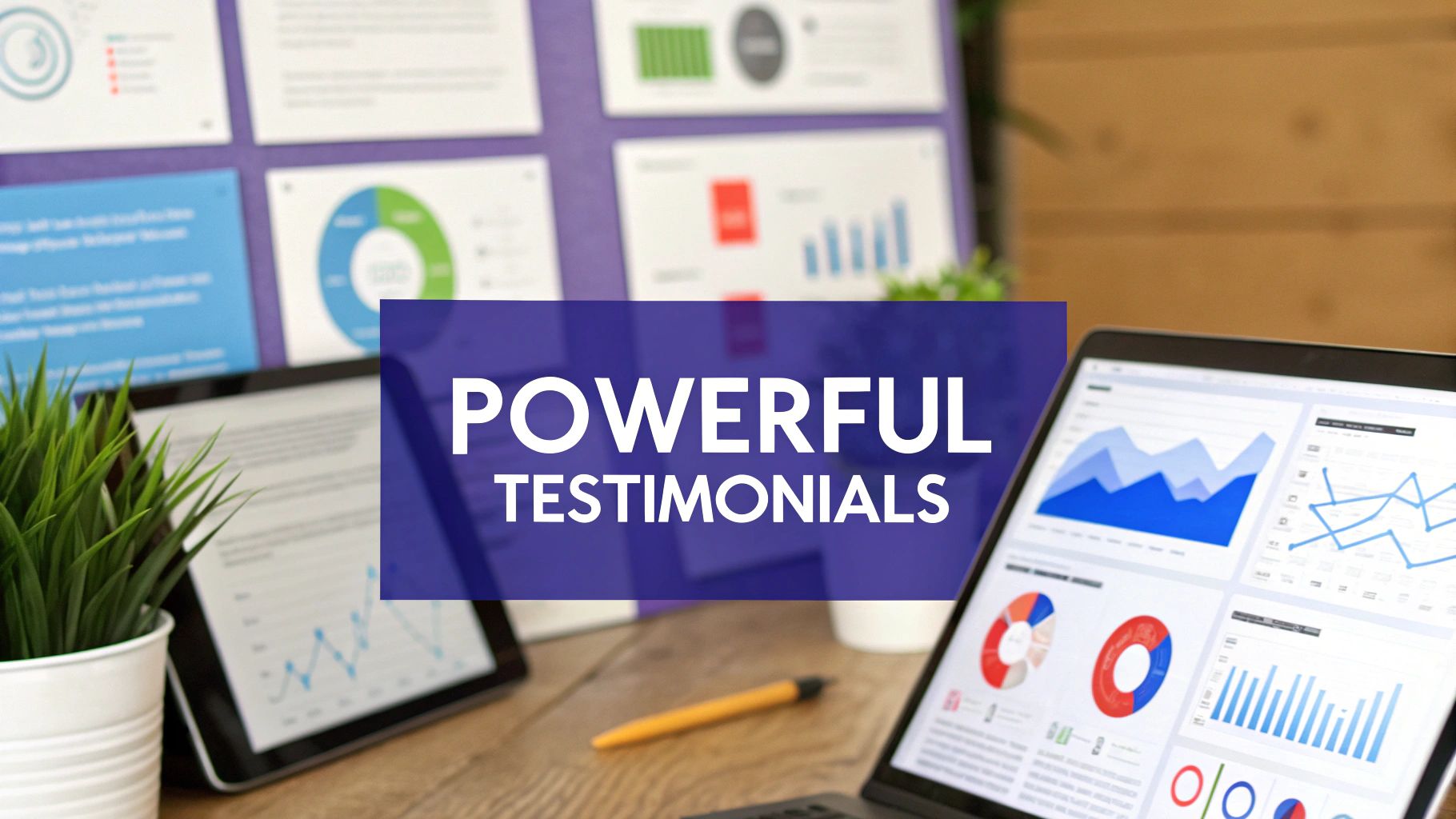12 Best Free Survey Tools for SaaS Teams in 2025
Looking for the best free survey tools? We review 12 top options, covering features, limits, and ideal use cases for SaaS companies to gather feedback.
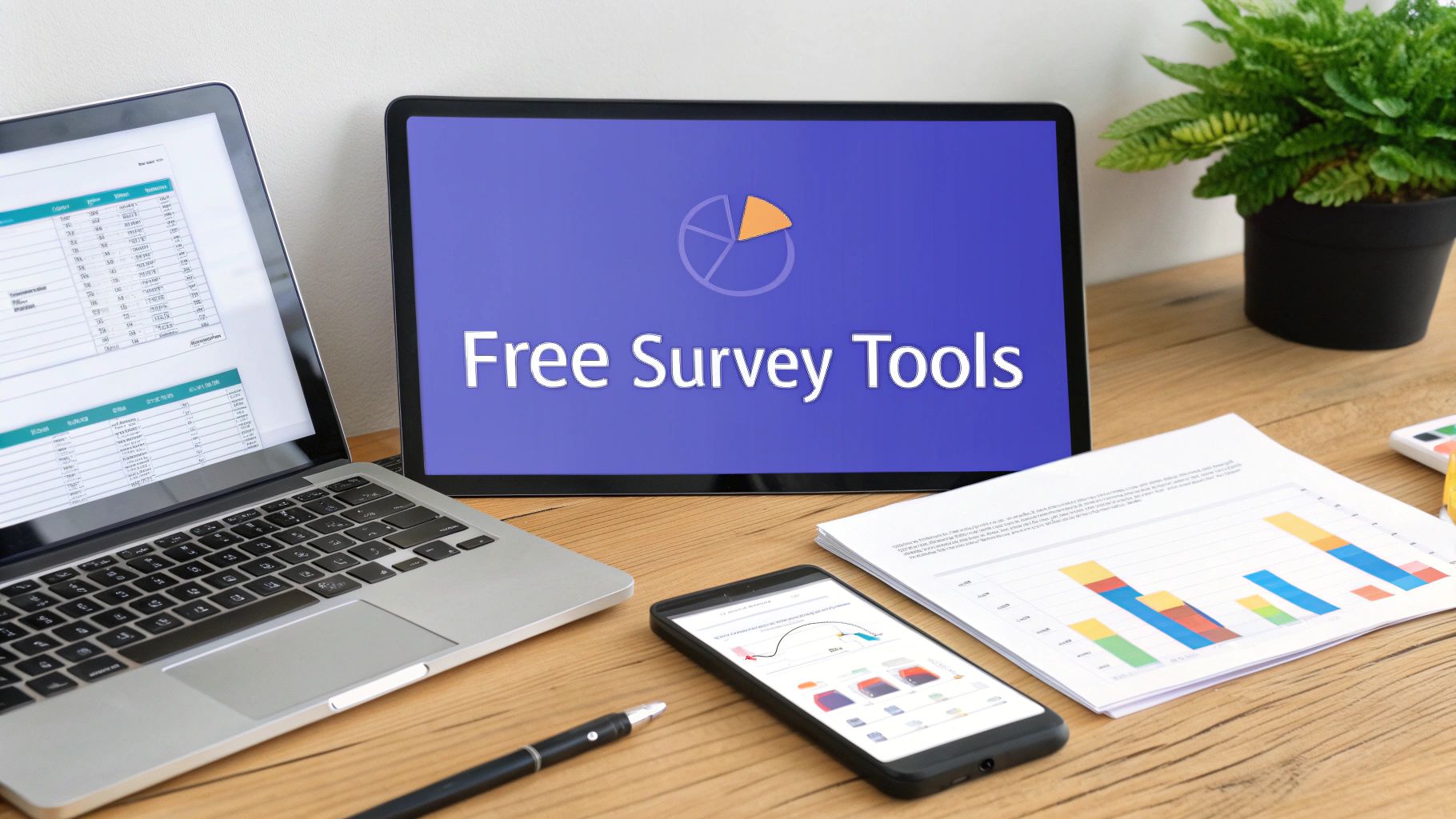
Gathering customer feedback, validating product ideas, or measuring employee satisfaction requires the right tool. Finding the best free survey tools can be a challenge, with many platforms offering limited features behind a paywall. This guide cuts through the noise to provide a detailed look at the top free options available, helping your SaaS team collect the data it needs without impacting your budget. We will move beyond simple feature lists and provide a practical analysis of each platform.
This resource is designed for product managers, marketers, and founders who need reliable data collection methods. Before you look into specific tools, it's helpful to know the critical distinction between surveys and questionnaires to make your data collection efforts precise and effective. Knowing this difference will help you select the ideal tool for your specific goal, whether it's a quick poll or a wide-ranging research project.
Each review in this article breaks down the platform's core strengths, potential limitations, and ideal use cases. You will find screenshots for a visual reference and direct links to get started immediately. We'll examine platforms like Google Forms, Typeform, Jotform, and Tally, evaluating them on criteria such as response limits, question types, customization options, and integration capabilities. By the end of this list, you will have a clear picture of which free survey tool best fits your team's workflow and data collection objectives, allowing you to make an informed decision quickly.
1. Google Forms
Google Forms is often the first tool teams reach for when they need a quick, no-cost way to gather feedback. Its primary strength lies in its seamless integration with the Google Workspace ecosystem, making it one of the best free survey tools for teams already using Google Drive, Docs, and Sheets. The platform is completely free for anyone with a Google account.
The user experience is straightforward for both creators and respondents. Building a form involves a simple drag-and-drop interface with basic question types like multiple-choice, short answer, and file uploads. For respondents, the clean layout works well on any device, which helps maximize completion rates.
Core Features & Limitations
Data collection is where Google Forms really shines for SaaS teams. All responses can be automatically synced to a Google Sheet in real-time. This creates a live database that can be used for analysis, reporting, or even as a simple data source for other applications.
However, its simplicity is also its main limitation. Customization options are minimal; you can add a header image and change colors, but you can't significantly alter the layout or branding to match your company's aesthetic. There's also no official hard cap on responses, but it is subject to Google's general storage and anti-abuse policies, which can be a concern for large-scale surveys.
Best for:
- Internal team feedback (e.g., post-sprint retrospectives).
- Simple customer satisfaction (CSAT) or Net Promoter Score (NPS) surveys.
- Quick validation of a new feature idea with a small user segment.
Pro Tip: Use the response validation feature to support data quality. For example, you can require users to enter a valid email address or a number within a specific range, which keeps your raw data clean from the start.
- Website: Google Forms
2. Microsoft Forms
Microsoft Forms is the default survey solution for organizations heavily invested in the Microsoft 365 ecosystem. While a personal Microsoft account offers a free version, its true power is unlocked for business and education subscribers, making it one of the best free survey tools for teams using SharePoint, Teams, and Excel. It's included with most Microsoft 365 business and school plans.
The user experience feels familiar to anyone who uses Office products. The interface for building surveys is clean and intuitive, offering standard question types and simple theming options. For respondents within an organization, single sign-on makes the process frictionless, which can improve internal survey participation.
Core Features & Limitations
Integration is the standout feature for Microsoft Forms. Responses can be exported directly to Excel for deeper analysis, and surveys can be embedded into SharePoint pages or shared as polls within Microsoft Teams channels. This creates a cohesive workflow for collecting and acting on feedback without leaving the Microsoft environment. For enterprise and school tenants, the platform supports up to 5 million responses per form, a massive scale for large-scale feedback initiatives.
The primary limitation is the significant difference between the personal and organizational versions. The free version for personal accounts has a low response cap of just 200, which is restrictive for external customer surveys. Advanced features and the high response limits are only available to paying Microsoft 365 subscribers, making it less of a truly "free" tool for teams outside that ecosystem.
Best for:
- Company-wide internal surveys on an intranet (via SharePoint).
- Quick polls and feedback collection within Microsoft Teams channels.
- Educational institutions gathering feedback from students and staff.
Pro Tip: Use the "Branching" feature to create dynamic surveys. You can show or hide questions based on a respondent's previous answers, allowing you to create more personalized and relevant survey paths for different user segments.
- Website: Microsoft Forms
3. SurveyMonkey
SurveyMonkey is one of the most recognized names in the online survey space, offering a robust platform that scales from simple polls to complex enterprise research. Its free "Basic" plan provides a solid entry point, making it one of the best free survey tools for those who may need to upgrade to more powerful features later. The free plan is designed for small-scale projects and personal use.
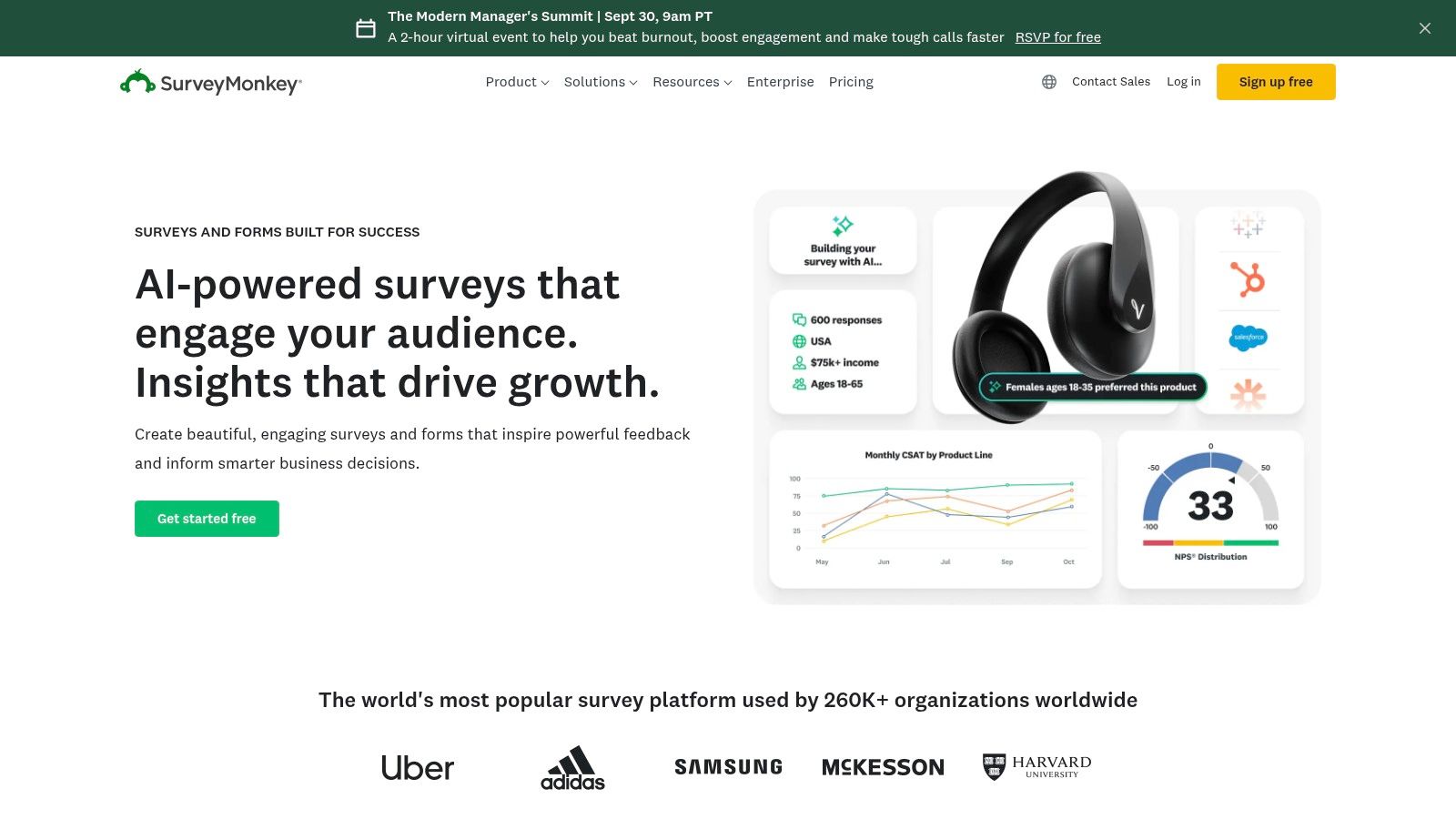
The user experience feels polished and professional. Survey creation is intuitive, with a vast template library to get started quickly. While the free version is functional, its primary purpose is to introduce users to the platform's more advanced, paid capabilities.
Core Features & Limitations
The free plan allows unlimited surveys with up to 10 questions each, which is suitable for brief feedback forms. However, the most significant limitation is the response cap; you can only view the first 10 responses per survey. To access more, you must upgrade to a paid plan. This makes the free version less viable for any survey expected to get a high volume of replies.
On paid tiers, SurveyMonkey offers sophisticated features like advanced skip logic, A/B testing, and powerful analytics tools that go far beyond what simpler tools provide. For a deeper look into the platform's capabilities, you can explore more about SurveyMonkey's features. The platform’s strength is its ability to grow with your team's needs, from a basic free tool to a comprehensive research suite.
Best for:
- Small-scale, targeted feedback where response volume is low.
- Teams evaluating survey platforms with the intent to upgrade.
- Quick polls for personal projects or very small teams.
Pro Tip: Use the free plan to test your survey design and question phrasing with a small pilot group. This allows you to refine your survey and justify upgrading to a paid plan once you are ready for a full-scale launch.
- Website: SurveyMonkey
4. Typeform
Typeform stands out by turning data collection into a conversational experience. It presents questions one at a time, creating an engaging flow that feels more like a chat than a traditional form. This user-centric design makes it one of the best free survey tools for capturing audience attention, particularly for marketing campaigns and user onboarding.
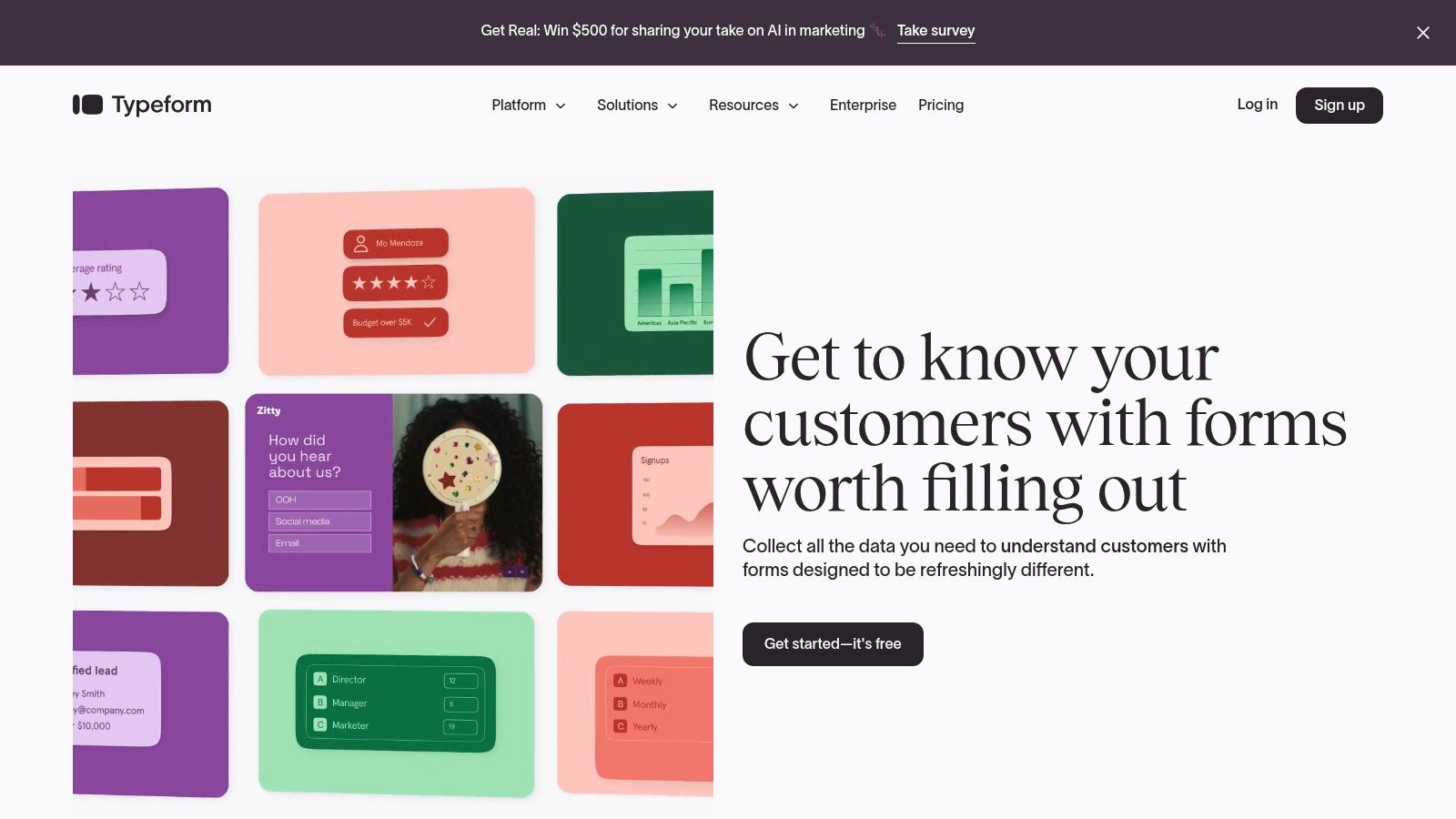
The platform’s free plan, while limited, is surprisingly powerful. You can build visually appealing surveys with advanced features like Logic Jumps, which change the questions a respondent sees based on their previous answers. This allows even free users to create personalized and dynamic feedback loops.
Core Features & Limitations
Typeform's main advantage is its exceptional user experience, which often leads to higher completion rates compared to static forms. The free plan also includes integrations with key marketing and payment tools like Stripe, Google Analytics, and Google Tag Manager, making it valuable for lead generation and simple transactions.
The most significant drawback is the strict response limit on the free tier. At only 10 responses per month, it’s not suitable for large-scale feedback collection. Once the limit is reached, the form automatically closes, which can be a problem for ongoing surveys. The free plan is best seen as a trial or for very small, targeted use cases. Many teams are exploring how AI can enhance survey creation to make tools like Typeform even more efficient.
Best for:
- Interactive lead-generation quizzes.
- New user onboarding feedback.
- Collecting applications or registrations for small events.
Pro Tip: Use the "Hidden Fields" feature to pass data into your Typeform through the URL. This allows you to track where respondents are coming from or pre-fill information you already know, personalizing the experience and saving users time.
- Website: Typeform
5. Jotform
Jotform positions itself as a powerful and versatile form builder that goes far beyond simple surveys. Its main appeal is a massive template library and extensive integration capabilities, making it one of the best free survey tools for teams that need to deploy functional, multi-purpose forms quickly. The free "Starter" plan is generous enough for small-scale projects and initial data collection efforts.

The platform’s user experience is highly visual, relying on a drag-and-drop editor that makes complex form creation feel straightforward. For respondents, the forms are professional and mobile-responsive, which helps maintain a positive brand impression. This balance of power and ease of use makes it a strong contender for teams without dedicated development resources. You can read a more in-depth comparison of Jotform features for further details.
Core Features & Limitations
Jotform’s free plan allows for up to 5 active forms and 100 monthly submissions, which is a key differentiator. It also includes access to over 10,000 templates, conditional logic, and integrations with popular apps like Slack, Dropbox, and various payment processors. This allows teams to create everything from simple feedback forms to basic order forms without writing any code.
The primary limitation of the free tier is the mandatory Jotform branding on all forms and a relatively low monthly submission cap. While 100 submissions are great for small tests or internal use, they can be quickly exhausted by a successful customer-facing survey. The upgrade paths are clear, but teams anticipating high response volumes will need to budget for a paid plan.
Best for:
- Collecting user feedback that requires payment integration (e.g., paid beta sign-ups).
- Event registration or webinar sign-up forms.
- Multi-step application or lead generation forms that require conditional logic.
Pro Tip: Leverage the vast template library to kickstart your survey design. Instead of building from scratch, find a template that closely matches your needs and customize it. This can save hours of setup time and provides a professionally designed starting point.
- Website: Jotform
6. Zoho Survey
Zoho Survey is an excellent entry point into a broader business ecosystem, offering a free plan that is both functional and a gateway to Zoho’s suite of products. As one of the best free survey tools for small to mid-sized businesses, its strength is its ability to scale with your company, providing a clear upgrade path from a simple free tool to a powerful, integrated data collection platform.
The user experience for survey creation is clean and intuitive, guiding users through the process without a steep learning curve. The free plan is generous enough for targeted feedback campaigns, allowing for embedding on websites and sharing via social media, which is perfect for capturing customer sentiment right where they are.
Core Features & Limitations
Where Zoho Survey stands out is its integration potential, particularly with Zoho CRM. While this is a paid feature, it highlights the platform's focus on turning survey data into actionable business intelligence. The free plan itself provides basic export options, allowing teams to get their data out for manual analysis.
The primary limitation of the free plan is the cap of 10 questions and 100 responses per survey. This makes it unsuitable for in-depth research but keeps it focused on quick, high-impact feedback collection. Branding options are also reserved for paid tiers, so free surveys will carry Zoho branding.
Best for:
- SMBs already invested in or considering the Zoho ecosystem.
- Simple lead generation forms embedded on a website.
- Quick event registration or post-webinar feedback.
Pro Tip: Use the 10-question limit strategically. Focus each survey on a single, specific goal, like gauging interest in a new feature or collecting initial CSAT scores, rather than trying to cover multiple topics at once.
- Website: Zoho Survey
7. SurveyPlanet
SurveyPlanet stands out in the crowded market with one of the most generous free plans available. It offers unlimited surveys, unlimited questions, and unlimited responses at no cost, which makes it an excellent choice for teams needing to conduct high-volume research without an immediate budget. This makes it one of the best free survey tools for capturing large datasets from the start.
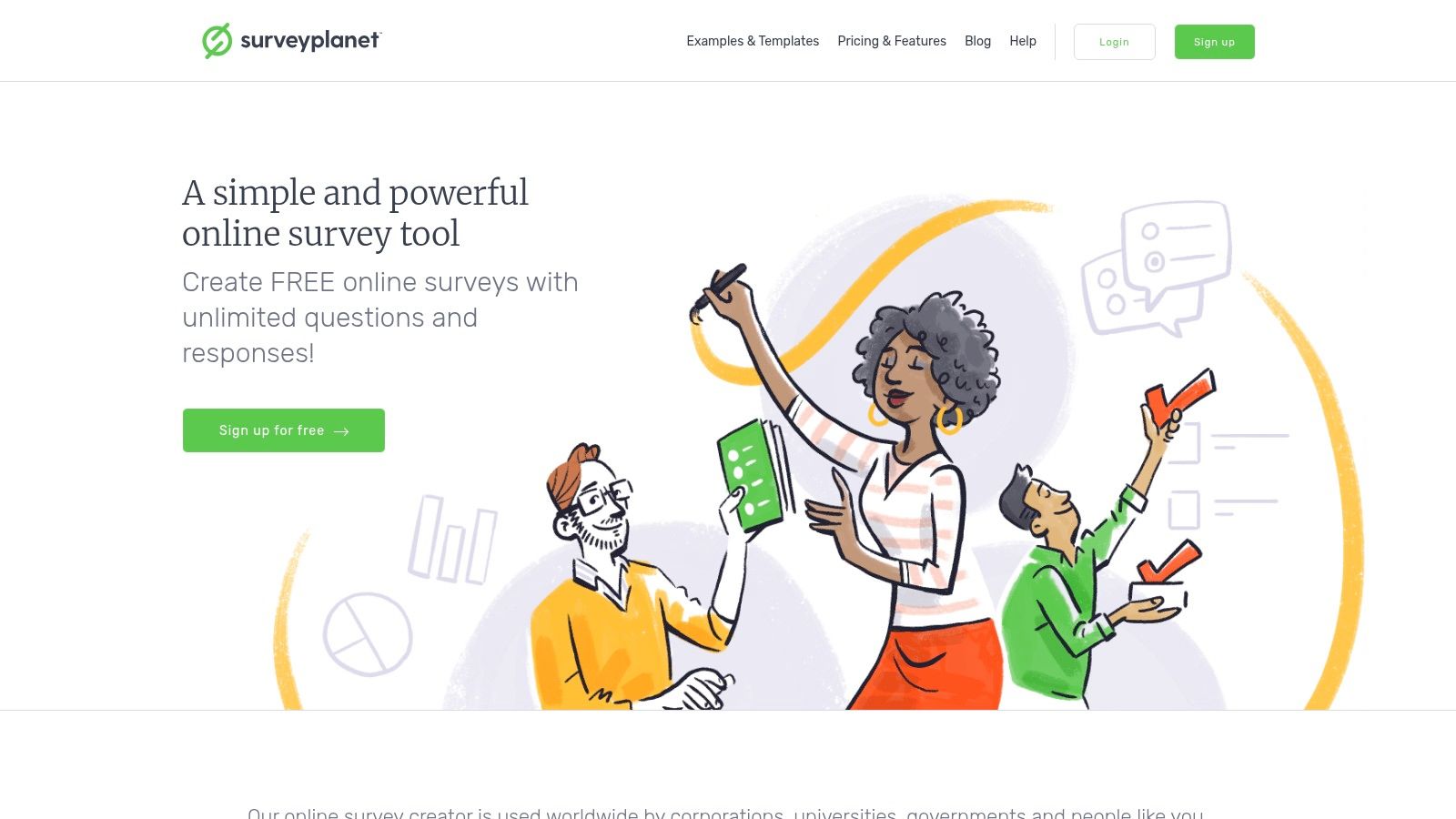
The user interface is clean and straightforward, allowing new users to build and launch a survey quickly. Respondents get a simple, intuitive experience, and all surveys come with SSL security to protect respondent data. While the free plan is powerful for data collection, it keeps advanced features behind its Pro subscription.
Core Features & Limitations
The main appeal is the lack of hard caps on the free tier, which is a significant advantage over competitors that limit responses or questions. Free users get access to basic reporting features, which are enough for a general overview of results. You can see response summaries and charts directly within the platform.
However, exporting your data to a CSV file for deeper analysis in another tool requires a Pro subscription. The free plan also lacks advanced logic like question branching and offers very limited branding customization. To get white-label surveys or apply custom themes that match your company’s brand, you will need to upgrade.
Best for:
- High-volume, simple feedback campaigns (e.g., event feedback from thousands of attendees).
- Academic or market research projects with a large, undefined number of respondents.
- Startups testing the waters with a new product idea on a massive scale.
Pro Tip: Use the anonymous survey setting on the free plan to encourage more honest feedback on sensitive topics. Since there are no response limits, you can gather a large volume of candid opinions without cost.
- Website: SurveyPlanet
8. Tally
Tally has quickly become a favorite in the no-code community for its incredibly generous free tier and Notion-like editing experience. It operates on a "99% of features are free" model, making it one of the best free survey tools for startups and teams that need advanced capabilities without an initial investment. The platform is free for unlimited forms and submissions.

The user experience feels modern and intuitive, particularly for those familiar with document editors like Notion. You simply type on the page to add questions, blocks, and logic, which significantly lowers the barrier to creating complex, multi-path surveys. Respondents get a clean, minimalist interface that works seamlessly on any device.
Core Features & Limitations
Tally's free plan is its standout feature, offering unlimited forms, unlimited submissions, and access to advanced logic and calculation fields. This allows teams to create sophisticated surveys for product feedback, lead generation, or user research without hitting a paywall. Integrations with tools like Zapier, Make, and Airtable are also available on the free plan, which is rare.
The primary limitation is that collaboration and team-oriented features are reserved for the Tally Pro plan. While you can create and share forms freely, features like custom domains, team workspaces for shared editing, and removing Tally branding require an upgrade. However, for most individual users or small teams just starting out, the free offering is more than sufficient.
Best for:
- Detailed user research surveys with conditional branching logic.
- Interactive quizzes or lead-generation forms with calculated fields.
- Collecting applications or registrations without submission limits.
Pro Tip: Use Tally's "hidden fields" feature to pass data into your survey via the URL. You can pre-fill information like a user's name or email to create a personalized experience and reduce friction for your respondents.
- Website: Tally
9. LimeSurvey
LimeSurvey stands out for teams that prioritize data ownership and extreme customization. It is an open-source platform, and its free Community Edition can be downloaded and hosted on your own servers. This approach gives you complete control over your data and infrastructure, making it one of the best free survey tools for organizations with strict security or compliance requirements.

The platform offers a powerful survey builder with extensive question types and advanced logic. While there is a learning curve, the user experience for creators is highly flexible once mastered. Respondents receive a clean, functional survey interface that performs well on different devices.
Core Features & Limitations
The open-source nature of LimeSurvey is its biggest asset. You can modify the source code, apply custom themes to perfectly match your brand, and extend its functionality with a wide array of plugins. There are no vendor-imposed limits on surveys, questions, or responses, which is a major advantage for large-scale research projects.
However, the self-hosting model introduces a significant technical barrier. You need server administration knowledge to install, maintain, and secure the software. While the ComfortUpdate extension simplifies upgrades, day-to-day management remains your responsibility. This technical overhead can be a major hurdle for teams without dedicated IT support.
Best for:
- Academic institutions or government bodies with on-premises data policies.
- SaaS companies needing full control for GDPR or HIPAA compliance.
- Technically skilled teams looking for a powerful, endlessly customizable survey engine without subscription fees.
Pro Tip: Before committing to self-hosting, explore the LimeSurvey plugin marketplace. Many community-developed extensions can add advanced features like payment gateways or sophisticated reporting, saving you significant development time.
- Website: LimeSurvey
10. Sogolytics (formerly SoGoSurvey)
Sogolytics, previously known as SoGoSurvey, is an enterprise-focused survey platform that offers a capable free plan for simpler projects. It positions itself as a more robust alternative to basic form builders, providing a glimpse into advanced features like branching logic and multilingual support, even on its free tier. This makes it one of the best free survey tools for teams that anticipate needing to scale their feedback operations in the future.
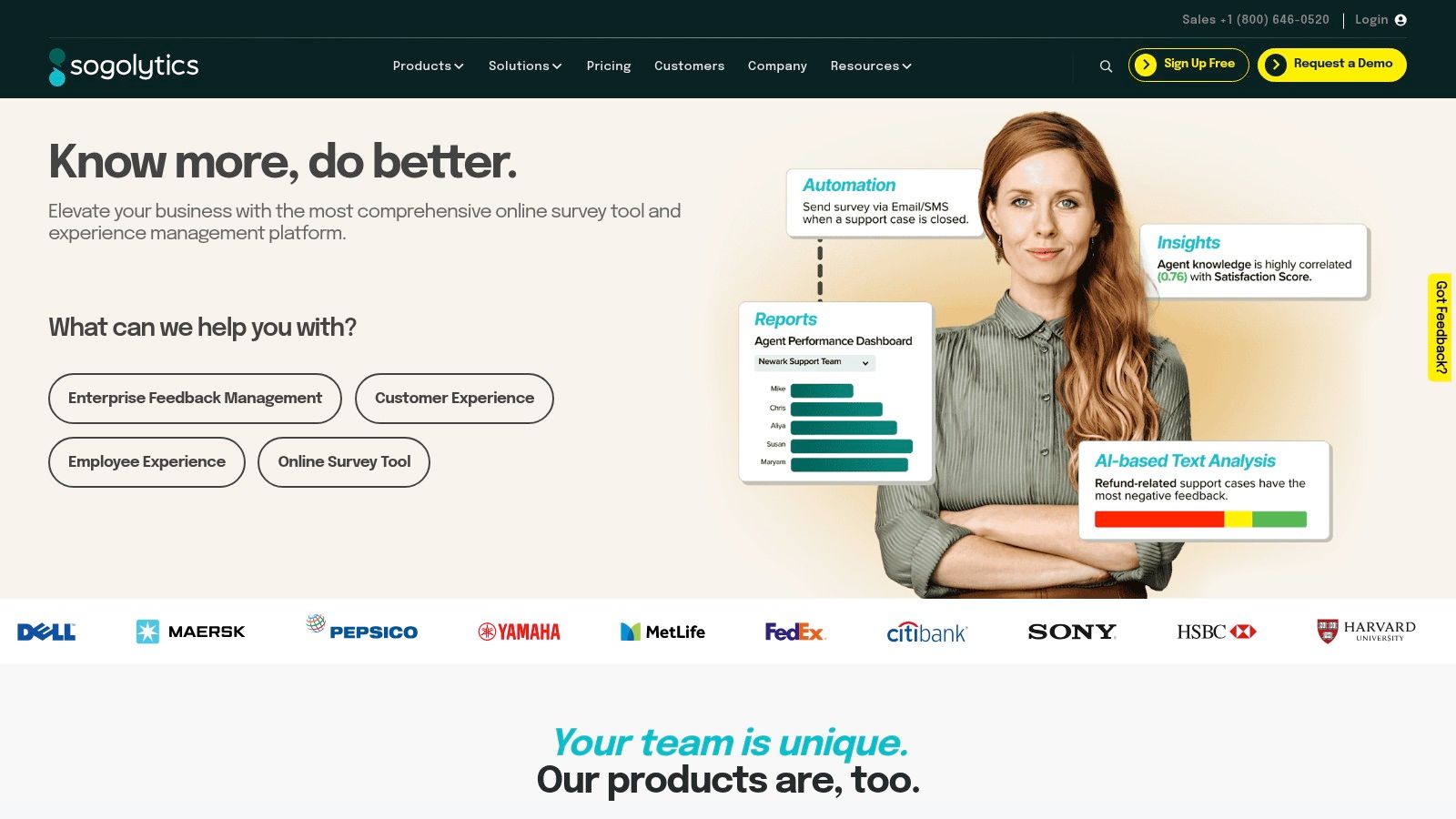
The user interface feels professional, though it can be more complex than some simpler tools. Creating a survey involves a structured process, and the free "Basic" plan includes unlimited surveys and questions, which is a generous starting point for any small-scale data collection effort.
Core Features & Limitations
The free plan's inclusion of basic branching (skip logic) and support for multiple languages is a significant differentiator. While many free tools are single-language only, Sogolytics allows you to reach a broader audience from the start. Security is also a clear priority, with HTTPS and multi-factor authentication available across all plans.
However, the free plan is a clear entry point to their paid services. Advanced logic, reporting dashboards, and higher response allowances are reserved for paid tiers. The specific response limit on the free plan is not prominently published, which can create uncertainty for projects that might grow unexpectedly. The platform is powerful, but its full potential is only unlocked with a subscription.
Best for:
- Small businesses testing a more professional survey tool before committing.
- Projects requiring basic multilingual capabilities without a budget.
- Teams that need a secure platform and plan to scale to an enterprise solution.
Pro Tip: Use the branching logic feature on the free plan to create a more personalized experience. You can guide respondents down different question paths based on their initial answers, which helps improve completion rates and gather more relevant data.
- Website: Sogolytics
11. SurveyLegend
SurveyLegend positions itself as a design-focused, mobile-first survey builder, making it a strong choice for SaaS companies targeting a mobile-savvy audience. Its "Starter" plan is free forever and emphasizes creating a visually engaging experience that looks great on any device, especially phones and tablets. This focus on aesthetics helps it stand out among more utilitarian options.
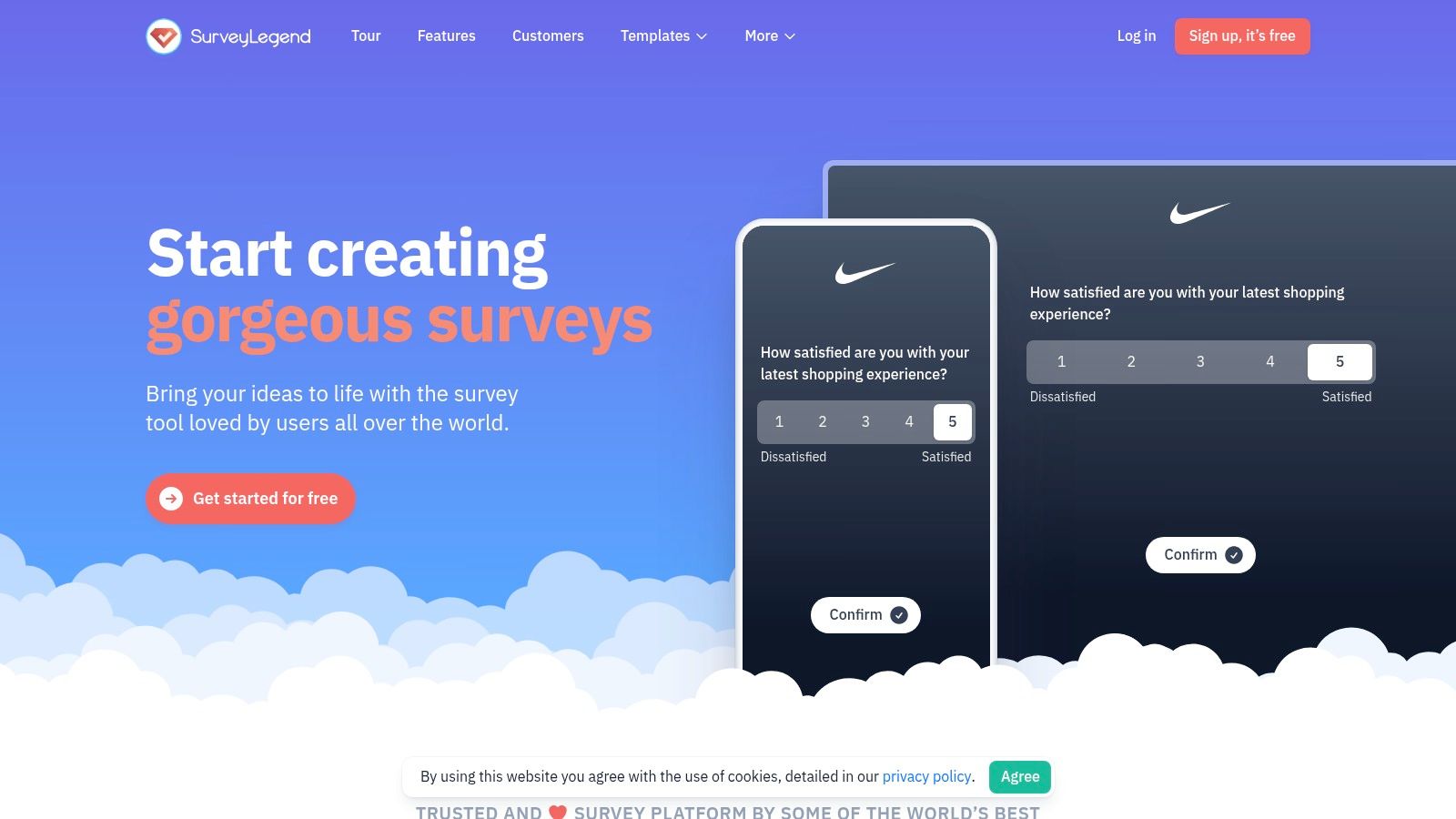
The free plan is suitable for light usage, offering up to three surveys with 1,000 responses each. This is a generous response limit compared to many competitors, making it one of the best free survey tools for projects that need significant volume without a paid subscription. The platform’s analytics are presented in a clean, real-time interface that simplifies data interpretation.
Core Features & Limitations
The mobile-first design is SurveyLegend’s main strength. Surveys are built to be interactive and visually appealing, which can lead to higher completion rates from users on mobile devices. The free tier even includes one conditional logic path per survey, allowing for some basic branching to create a more relevant respondent experience.
However, the free plan has significant limitations for business use. It displays SurveyLegend ads and a watermark, which may not align with professional branding. The most critical drawback is the lack of a data export feature; you can view analytics on the platform but cannot download your raw data as a CSV or Excel file. This makes deep analysis or integration with other tools impossible without upgrading.
Best for:
- Gathering feedback from a primarily mobile user base.
- Visually driven polls or questionnaires for social media campaigns.
- Student projects or non-profit initiatives where branding is less of a concern.
Pro Tip: Use the visual editor to its full potential by adding background images and customizing the look and feel. A well-designed survey feels less like a chore and can improve the quality of responses, even if the branding is not your own.
- Website: SurveyLegend
12. Qualtrics (Free Account)
Qualtrics is an enterprise-level research platform known for its advanced capabilities, but its free account offers a valuable entry point. This makes it one of the best free survey tools for teams wanting to test a powerful, professional-grade system before committing. The free version provides access to the core survey builder used by top universities and corporations, offering a taste of its robust architecture.
The user experience feels more structured and academic compared to simpler tools, reflecting its research-oriented background. While the interface is clean, building a survey involves more steps than a drag-and-drop tool. However, this structure provides greater control over survey logic and flow, even in the free tier.
Core Features & Limitations
The Qualtrics free account is built for small-scale projects and pilots. You get three active surveys at a time, with up to 30 questions each, and can collect a total of 500 responses across your account. It includes eight core question types and basic conditional logic, allowing for more sophisticated question paths than many other free options.
The primary limitation is the tight response and survey cap. Advanced analytics, complex logic, and specialized question types like heatmaps or conjoint analysis are locked behind a paid license. The free plan is more of a gateway to their powerful paid ecosystem than a long-term, high-volume solution.
Best for:
- Academic research projects or pilot studies for students.
- SaaS teams testing the platform's advanced capabilities before a purchase.
- Creating a highly professional-looking survey for a small, targeted audience.
Pro Tip: Use the free account to build out a proof-of-concept for a complex research project. This allows you to demonstrate the value and secure budget for a full license by showing stakeholders exactly how the platform works.
- Website: Qualtrics Free Account
Top 12 Free Survey Tools Feature Comparison
Final Thoughts
We've explored a wide range of the best free survey tools available today, each offering a distinct set of features and limitations. From the straightforward utility of Google Forms to the advanced logic of a free Qualtrics account, the right tool for your SaaS team is on this list. The key is to move beyond a simple feature comparison and align your choice with your specific goals, technical resources, and desired respondent experience.
Making a decision requires finding the tool that integrates smoothly into your existing workflow and scales with your needs. A free plan is a fantastic starting point, but it's important to know its boundaries. Knowing when you'll hit a response limit or need a feature locked behind a paywall will prevent future disruptions.
How to Choose the Right Free Survey Tool for Your SaaS
Selecting the ideal platform requires a strategic approach. Before you commit, even to a free tool, work through these considerations with your team to clarify your objectives.
Define Your Primary Use Case: What is your immediate goal? A simple NPS survey for your customer success team has different requirements than a complex market research questionnaire led by your marketing team. A tool like Tally is excellent for creative, form-based interactions, while Google Forms is perfect for quick, internal data collection.
Evaluate the User Experience (for Respondents): The look and feel of your survey directly impact completion rates. For brand-conscious SaaS companies, a tool like Typeform or SurveyLegend provides a polished, engaging experience that reflects a modern tech brand. A clunky or confusing interface can lead to survey abandonment and skewed data.
Assess Integration Needs: Your survey tool should not operate in a vacuum. Consider how it will connect with your CRM, analytics platform, or communication tools. Tools like Jotform and Zoho Survey often have robust native integrations, which can save your team significant development time. Always check if a Zapier or Make connection is available for tools that don't directly integrate with your stack.
Plan for Future Growth: The free plan you start with might not be the one you stick with. Look at the paid tiers of your top choices. Does the pricing scale reasonably? Does the next tier up unlock the specific features you anticipate needing, like advanced branching logic, custom branding, or priority support? Choosing a tool with a logical upgrade path, like SurveyMonkey or Sogolytics, can make future transitions much easier.
Key Takeaways and Your Next Steps
The selection of free survey software is rich with powerful options, making valuable customer and market insights more accessible. Your main task is to cut through the noise and identify the platform that aligns with your team's specific context.
Start by shortlisting two or three tools from our list that seem like a good fit. For example, if you need unlimited questions and a high response volume, LimeSurvey or Microsoft Forms might be your top contenders. If aesthetic and user engagement are paramount, focus on Typeform or Tally.
Once you have your shortlist, run a small, low-stakes pilot project. Create a test survey and share it internally. This hands-on experience is the best way to evaluate the builder's interface, test the respondent experience, and see how the data is presented in the results dashboard. This simple test will reveal nuances and usability quirks that you can't find on a pricing page.
Ultimately, the best free survey tools give you the power to listen to your users, validate ideas, and make data-informed decisions without a significant financial investment. By choosing wisely, you can build a powerful feedback loop that fuels your product's growth and strengthens customer relationships.
Tired of manually analyzing open-ended survey responses? Surva.ai uses AI to automatically categorize and analyze qualitative feedback from any survey tool you choose, saving your team hundreds of hours. Connect your favorite tool and turn raw text feedback into actionable insights in minutes by visiting Surva.ai.
